
East elevation
[Master Plan] [Introduction] [Development] [Timeline] [Existing Conditions] [Recommendations] [Bibliography]
| Master Plan For | |||
| The Restoration Of | |||
| The Dimmit County Courthouse | |||
Problems with the roof of the courthouse have persisted throughout the years. The first mention of such problems occurred in 1940 when Dimmit County Commissioners Court minutes reveal the need for water proofing and repair
|
|
|
East elevation |
of the cornice to ensure proper drainage. The minutes, however, do not reveal if the work was actually accomplished, as no mention of a contract was found. In 1959, repairs to the roof were conducted by a local contractor for $1,710. The need for additional roof repairs became critical in 1976 with concern expressed for potential water damage to the carpeting in the courtroom.
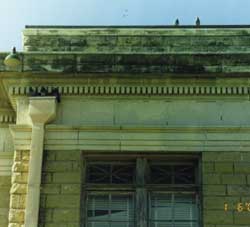 |
|
North elevation |
A contract, however, was not let for roof repairs until February of 1982.
These earlier repairs did not solve the drainage problems of the roof, however, and an entirely new roof was constructed on the courthouse with drainage modifications in 1997. These modifications included the installation of metal flashings, new roof drains and an enlarged ten inch downspout. It appears that these repairs dramatically reduced the water problems that had earlier plagued the courthouse. The many years of inadequate drainage, however, took their toll on the structure and have resulted in serious structural problems with the cornice.
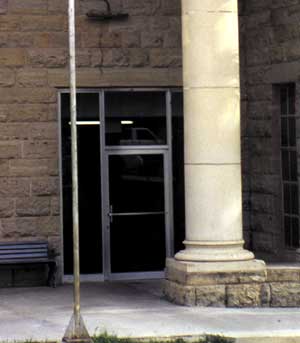 |
|
Detail of front porch (west elevation) |
The exterior walls of the courthouse are constructed with limestone block. In general, the blocks appear to be in very good condition with the exception of two areas. Some minor discoloration of the blocks and deterioration of the joints are evident in the vicinity of the downspouts at the east wall (see above photograph of east elevation). This appears to have been caused by water overflow from the roof scuppers washing down the wall. In addition, there exists deterioration of portions of stone at the bottom of the west wall at the main entrance along the lower base courses. Water trapped against the wall and under the adjacent sidewalk have resulted in spalling and discoloration of the stone at this location. The existing tan mortar is deteriorating in some areas with considerable mortar damage around the courthouses cornice (see "Cast Stone Cornice", page 49).
ADA modifications executed in 1997 brought the courthouse building into full compliance with accessibility standards and resulted in the issuance of an ADA certification from the State of Texas. These modifications do not adversely impact the historic integrity of the courthouse, as neither existing exterior openings were modified nor were any ramps introduced near any of the exterior entrances. The ADA modifications for access to the building utilized existing at-grade sidewalks as much as possible. Access to the building leads from handicapped parking places on the north side of the building, up the sidewalk on the north side of the building to a perimeter sidewalk which extends around the building to the front entrance. Signs are posted all along this route to guide visitors to the courthouse. All ADA modifications received approval by the Division of Architecture, Texas Historical Commission.
There are three sets of exterior doors located on the north, south and west (main entry) facades of the courthouse. A single entry aluminum door capped with a fixed transom and flanked by sidelights is used on each of the three entries.
 |
 |
|
|
West door, main entry |
South door |
The original wood doors were replaced by the present aluminum doors in 1960. Historic doors are depicted in surviving photographs of the north and south entries which indicate the existence of double wooden doors with inset glass flanked by sidelights with wooden kickplates.
 |
 |
|
|
South door, early 1950s |
South door, circa 1940 |
The courthouse retains all of its original windows including several from the 1884 design on the west elevation. There are five different historic window types:
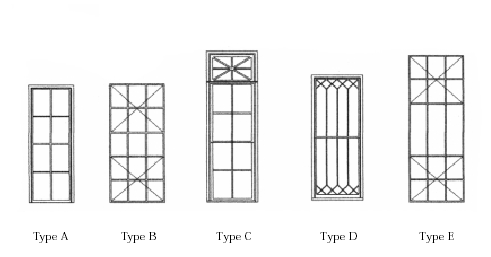 |
|
The window openings on the ground floor are shorter in height than those of the second floor, a feature found in the 1884 courthouse design which necessitated its incorporation into the 1926 remodeling. Window Type C is the most common found on the courthouse and is utilized throughout the second floor, except over the main entrance (Window Type E). This window type features 4/4 double-hung wooden sashes with a fixed transom adorned with a St. George’s Cross. Window Type A is a typical 4/4 double hung wooden window used only on the ground floor. Window types B and E are fixed metal casement with reinforced wire glass used on the south, north and west elevations for security where important documents were stored. Type B is a 6/9 configuration located only on the ground floor, while Type E is a tripartite arrangement of 6/3/6. The elongated proportions of this particular type were necessary for the upper floor where the window openings were elongated. Only window Type D are original to the 1884 building. These double hung, 1/1 wood windows are located only on the lower floor of the front entry porch to the courthouse. This particular window type features ornamental mullions forming a diamond pattern at top and bottom. Most of the windows are grouped in pairs, but are used singly when dictated by interior functions.
All of the windows need minor repairs, particularly the window casings and trim. Some rot and termite damage is evident in the interior frames, sills and trim, particularly on the ground floor windows. Windows located on the north and east facades are in good to fair condition and will require only sanding, refinishing and window adjustments. Windows located on the west facade are in fair condition with some minor damage. The south elevation windows have sustained the most extensive damage due to sun exposure. Approximately 20% of the windows are in need of new window frames, sash, and trim. New glazing is necessary for approximately 40% of all windows. Window hardware needs to be replaced for 80% of the windows, and weather stripping is required for approximately 90% of the windows. All windows are in need of sanding, refinishing, a primer and a finish of two coats of paint. Metal windows exhibit some rust. All windows have cast stone lintels, many of which are sagging and cracked.
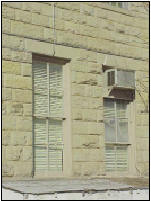 |
 |
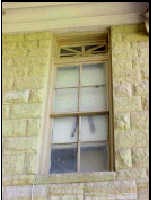 |
||
| Type A, east elevation | Type B, west elevation | Type C, west elevation | ||
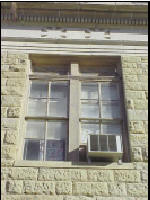 |
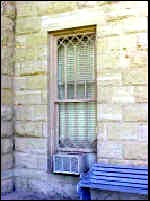 |
|||
| Type C, south elevation | Type D, west elevation |
The courthouse features a deeply projecting cornice on all elevations. The stone of the cornice is in very good condition, but serious problems exist in the structuring of the cornice. In March of 1995, approximately thirty five linear feet of cornice fell from the south portion of the east wall. On the advice of the Texas Historical Commission, additional cornice pieces were loosened; this created a domino effect, resulting in additional molding shearing away from the building. These problems resulted in the erection of a steel framed structure adjacent to the north entrance and the closing of the south entrance to protect pedestrians from falling pieces of terra cotta cornice. The cornice was reassembled and attached in 1998. Further investigation of the cornice from the roof reveals that portions of the cornice along the east end of the south wall have rotated. In addition, it was observed that the mortar joints between cornice pieces are cracked. Please see the structural analysis report by WSC, Inc. (page 76) for additional information and analysis.
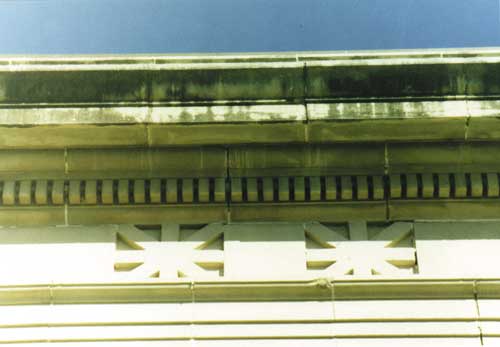 |
|
South elevation, east end of cornice |
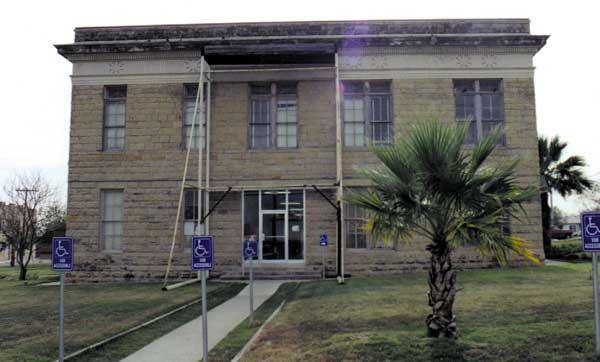 |
|
North elevation |
[Master Plan] [Introduction] [Development] [Timeline] [Existing Conditions] [Recommendations] [Bibliography]